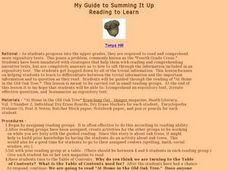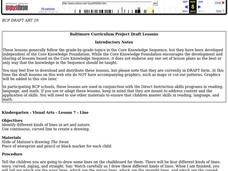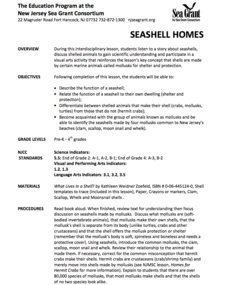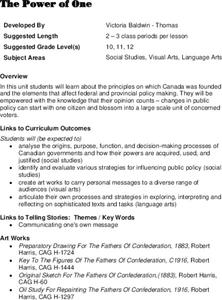Curated OER
Philanthropy in Literature Lesson 1: Definition of Terms
Students watch a video after which they define philanthropy and site examples of it in daily life. They use this definition as they work through the rest of the unit.
Curated OER
Interview for Reflection
Learners practice their interviewing skills using the elements of questioning. They write and illustrate a past experience of theirs doing a philanthropic act. They share their stories and illustrations to complete the lesson.
Curated OER
Domus Romana: A Roman House
Fourth graders study wealthy homes of Roman politicians. They explore a businessman's house and describe the types of activities that go on from there.
Curated OER
Government Lesson Plan: Lesson Plan 3
Students examine affirmative action policies. They analyze the positive/negative aspects of affirmative action. They study historical development and current status of principles, institutions, and processes of political systems.
Curated OER
PBS Kids Go Buster Buffalo Round-Up
Second graders visit Rapid City, South Dakota, and Jackson Hole, Wyoming in these two episodes of Buster. They examine the Lakota people in South Dakota to see what it means to persevere. They sing songs and study idioms. They brainstorm...
Curated OER
My Guide to Summing It Up
Students are broken into reading groups based on reading ability and rotate one group at a time reading with the teacher at a table. They discuss the function of the Table of Contents and find a story using it and predict what the story...
Curated OER
Fishbone Diagram
In this literacy worksheet, students use the created resources for further progress towards knowledge. The sheet is a teacher's guide for creating student resources.
Curated OER
Sondheim: Secret Metaphors
Students explore the work of Stephen Sondheim. In this musical theater lesson, students examine the musicals Merrily We Roll Along and Sunday in the Park with George. Students identify and anaylze linear and nonlinear structural patterns...
Curated OER
Visual Arts
Students identify different kinds of lines in art and nature. They use continuous, curved line to create a drawing.
Curated OER
At Play
Ninth graders evaluate works of Robert Harris. They apply historical methodology to interpret and understand time, continuity, and change at an age appropriate level. They demonstrate awareness of the effect of context.
Curated OER
Talking About the Future
Students investigate how to communicate about the future using the proper verb tense. In this communication about the future activity, students talk to a partner about future plans. They fill in an associated chart about the present...
Curated OER
Seashell Homes
Pupils listen to a story about seashells. They discuss shelled animals. Learners describe the function of seashell. Pupils relate the function of a seashell to their own dwelling. They differentiate between shelled animals that make...
Curated OER
Using computers in the content area
Students practice grade appropriate computer basics and integrate them into the curriculum areas. in this technology lesson, students understand correct behaviors while using the computer. Students become familiar with the Internet and...
Curated OER
Student D
Students are being evaluated on their math skills. In this algebra instructional activity, students review basic math skills and are being reviewed for leaning skills that may enhance or inhibit their learning skills. They are scored...
Curated OER
Would You Believe Your Eyes?
Learners study the parts and functions of the human eye. They create dodecagons which are twelve-sided figures with twelve equal angles and share these with the class so that each student can begin to see how many different illusions can...
Curated OER
Describe My City
Students explore the functions of cities by creating a visual image of their own neighborhood. Students diagram, list, and label the major businesses and cultural areas of the neighborhood where they grew up, then write a letter to a...
Curated OER
Lewis and Clark: Prized Possession
Students create a Sacagawea-inspired wampum belt. In this Native-American lesson plan, students study Sacagawea and her influence on the Lewis and Clark expedition. Students learn about wampum and prized possessions and work in groups to...
National Endowment for the Humanities
From Courage to Freedom: The Reality behind the Song
Learners study how Frederick Douglass uses language to describe a realistic picture of slavery in his writings which are primary source documents. They examine his use of word choice, imagery, irony, and rhetorical appeals and use slave...
Curated OER
Ants
Third graders study the habits and habitats of ants. They research the use of technology as a valuable investigation tool and access other web sites for future research projects. The students make successful decisions while playing SimAnt.
Curated OER
History of the American West
Ninth graders research early mining in California. They study the "placer method" for mining gold, which is surface mining that does not involve tunneling. They examine what it was like for the early miners to pan for gold with...
Curated OER
Create a City: An Urban Planning Exercise
Students explore the effects of population growth in Arizona. In this history activity, students work in small groups to create a "perfect" city. Activities include examining the Arizona census results then discussing the importance of...
Curated OER
The Power of One
Students study the principles on which Canada was founded. They examine the elements that affect federal and provincial policy making. They identify and evaluate various strategies for influencing public policies. They create a visual...
Curated OER
Hello My Name is . . . Helvetica
Students play various games to help create a classroom community. In this name recognition lesson, students combine their name recognition skills with newly learned art and geometric vocabulary. First students discover vocabulary that...
Curated OER
Plant Systems
Second graders learn about plant systems and how plants grow and function. In this plant lesson plan, 2nd graders collect data based on roots, leaves, terrariums, plant uses, and locations of certain kinds of plants. They fill out...

























